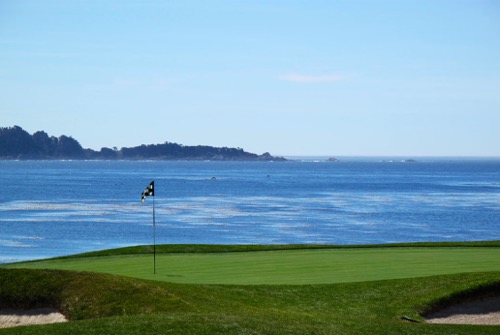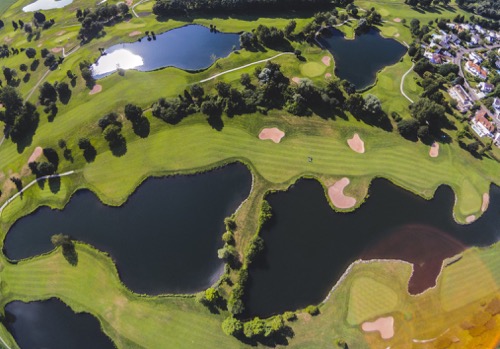Building a regulation 18-hole golf course is a massive undertaking that can easily cost tens of millions of dollars. From acquiring adequate acreage to shaping fairways, constructing facilities, and cultivating flawless playing surfaces, golf course development requires extensive capital outlays. The costs start accruing right from the initial land purchase and compound through design, construction, and long-term maintenance. While many factors influence the total price tag, from exclusivity of the location to extravagance of amenities, most courses will involve hefty investments to create an appealing layout. This blog provides an in-depth look at the typical expenses associated with building a golf course, including land acquisition, construction, infrastructure, equipment, and ongoing upkeep costs. Understanding the significant budgeting required can set realistic expectations for undertaking such a substantial project.

What are the costs of land for building a golf course?
The land purchase represents one of the biggest upfront costs when building a new golf course. The amount of acreage needed can vary greatly, but an 18-hole course generally requires 150 acres or more. In prime real estate locations near major cities, raw land can cost $500,000 per acre or higher. In more rural areas, costs may range from $5,000 to $50,000 per acre.
The terrain also factors into land costs – flatter properties will be cheaper than hilly areas requiring extensive grading. Developers need to consider whether the land holds any special value, like waterfront access or scenic vistas that could enhance the course but also drive up the price. Careful negotiations are important to get the best deal on what is often the largest capital expenditure for the project.
Financing options like land trusts, seller financing, or public-private partnerships may be explored to reduce upfront cash needs for purchasing course land. Though substantial, getting the land investment right is crucial for containing overall development costs and successes.
How much does it cost to design and construct the course layout?
Designing and shaping the course layout involves heavy upfront investments, typically ranging from $500,000 to over $1 million. The golf course architect fees alone can run between 5-10% of total construction costs. Sophisticated 3D design software and geological surveys are needed to map out fairway routing, drainage, and structural elements.
Moving large quantities of dirt and landscaping to create greens, tee boxes, fairways, bunkers and hazards is equipment-intensive. Many holes require over a hundred thousand cubic yards of cut and fill. Bulldozers, excavators, and dump trucks to move earth can all be rented but add up. Shaping crews, often with specialized experience in golf course construction, command premium per-hour pricing.
Building structural elements like ponds, creeks, and bulkheads for water hazards involves concrete, piping, and heavy equipment. Factors like unusual terrain or permitting costs for wetlands and creeks can drive layout costs even higher. Careful planning is essential to balance playability, natural aesthetics, and cost-effectiveness when constructing the course layout.

What expenses are involved in installing irrigation and drainage systems?
Installing specialized irrigation and drainage systems represents a significant chunk of golf course construction costs. An automated irrigation system using sprinklers and underground piping is essential for maintaining lush, playable turfgrass. Just the raw materials of PVC piping, high-capacity pumps, water storage tanks, and computer controls can cost upwards of $500,000. Trenching and burying the pipework adds additional equipment and labor costs.
Careful engineering is required to ensure adequate water flow and sprinkler coverage across sometimes hundreds of acres. Proper drainage is also critical. Underground storm drainage systems using perforated pipe, catch basins, and water retention ponds prevent flooding and ponding on fairways and greens. Sand and gravel for subsurface drainage layers further improve percolation. Conduit and wiring to control all systems remotely adds expense.
Ongoing costs also need to be accounted for, as irrigation and drainage systems require regular maintenance and repairs down the road. Proper installation by qualified golf course builders is advisable despite the significant upfront investment required.
How much does it cost to purchase grass, trees, bunkers and other landscaping?
The specialized landscaping and features on a golf course can run up a substantial tab. The desired playing surfaces of greens, tees, fairways and roughs require meticulous grass planting using premium turfgrasses like bentgrass, Bermuda grass or ryegrass. The seed and sod can cost over $100,000 for an 18-hole course.
Strategic tree planting for aesthetics and playability might include over a thousand mature trees at several hundred dollars apiece. Shaping and contouring sand bunkers takes specialized equipment and continual top-dressing with fresh sand. Bunker construction costs can exceed $250,000. Other amenities like water features, scenic gardens, and rock formations require extensive landscaping labor and materials. Ongoing turf maintenance equipment like mowers, aerators and fertilizer rigs represent additional expenses.
While greens and tees may need to be rebuilt every decade, proper upkeep to maintain ideal playing conditions involves continual turfgrass, bunker, and amenity investment. Careful planning and budgeting is necessary to strike the right balance between playability and landscaping costs.

What are the costs for golf cart paths, fencing, and other infrastructure?
Golf cart paths are essential infrastructure that provide routing throughout the course. Installing an asphalt or concrete cart path network can cost $500,000 or more for an 18-hole course. This covers materials like concrete or asphalt, in addition to grading and laying the pathways. Drainage elements like culverts need to be factored in too.
Safety fencing and netting are also important investments. Perimeter fencing to secure the course boundaries may cost upwards of $50,000. Safety netting to contain errant balls can run from $25,000 for a driving range up to $100,000 for the full course.
Other key infrastructure costs include signage, maintenance buildings, on-course restrooms, and halfway houses. High-quality course signs, tee markers and in-ground signage can ultimately cost over $100,000.
A sizeable maintenance facility for storing equipment and supplies may run $300,000. Simple on-course restroom facilities could be $50,000 each. More lavish halfway houses for food and beverage may cost $200,000 or more.
Proper budgeting for infrastructure covers the essential routing, safety, and support elements that allow an enjoyable golf experience. Though not directly tied to play, these items still represent key development costs.
How much does the clubhouse construction and facilities cost?
The clubhouse is the centerpiece facility at any golf course, but requires major investments. For an high-end 18-hole course, the clubhouse construction costs alone can easily exceed $5 million. This covers a lavish pro shop, locker rooms, full-service restaurant and bar.
Building the core structure for a palatial 20,000 square foot clubhouse starts around $300 per square foot. Finishes like stonework, timber beams and imported tiles add even more. That’s before any furnishings, kitchen equipment, or amenities are accounted for.
Golf simulators could cost $50,000 each. A well-stocked pro shop may carry $100,000 in merchandise. The commercial kitchen equipment to run a restaurant could be another $200,000.
Parking facilities, landscaping and exterior amenities around the clubhouse also require significant budgets. A luxurious grand entrance with water features could be $500,000.
Of course, more modest or even modular clubhouse options are available at the low end. But the clubhouse remains one of the biggest line items in a golf course construction budget, with many avenues for lavish investment depending on the target market.

What are the maintenance costs after construction is complete?
Ongoing maintenance costs after opening a golf course can easily exceed seven figures annually. Labor is a major cost, with crews for mowing, turf care, landscaping, and repairs. A premium golf course may employ over 50 grounds staff, with annual salary and benefits costing over $2 million.
Equipment costs are another big factor. A fleet of mowers, turf care rigs, bunker rakes and utility vehicles needs continual upkeep and replacement. Leasing agreements can minimize some upfront capital but require ongoing payments.
Turf care and amenity maintenance also add up. Annual costs for fertilizers, chemicals, seed and sod can reach six figures to keep greens and fairways immaculate. Bunkers may need fresh sand topping every year. Landscaping and water features require routine gardening, repairs and utilities.
Managing the clubhouse dining and recreation facilities comes with its own set of operating expenses as well.
Careful planning and budgeting is essential, as maintenance costs will usually surpass expenses in any other area after construction. Finding the right balance of conditions and playability is key for both golfer satisfaction and fiscal sustainability.
How can costs be reduced for building an affordable golf course?
Using a more compact course footprint is one effective way to reduce land acquisition and construction costs. Instead of sprawling over 200+ acres, limiting to 120 acres or less contains expense. Smaller greens, tees and narrowed fairways also require less turf establishment.
Scaling down in-course amenities is another option. Lavish waterfalls and landscaping can be nixed in favor of more natural, minimalist features. Bunkers and cart paths can be strategically limited as well.
The clubhouse is an area ripe for savings. Opting for a modular or pre-fabricated building costs a fraction of custom construction. The pro shop, restaurant and other facilities can also be simplified rather than deluxe.
Equipment purchases also present opportunities. Buying used machinery or entering rental agreements reduces capital outlay. Maintenance crews can be kept leaner if less intensive grooming standards are set.
Using drought-tolerant grasses like Bermuda can reduce irrigation demands. Drainage can rely more on natural topography rather than expensive stormwater systems.
While some premium features are expected, careful design and planning from the outset allows an appealing course to be constructed even on a budget.

What financing options are available for new golf course projects?
Traditional business loans from banks are one route for funding course development, though interest rates may be higher for what’s seen as a riskier recreational business. SBA-backed loans represent another possibility to secure favorable rates given their guarantee.
Equity financing is a common approach, with multiple investors buying ownership stakes in the golf course and land development. This spreads risk and capital requirements.
Municipal bonds may finance publicly-accessible or city-owned courses, secured by future tax revenue rather than club profits. Land grants are another public funding method.
Developer partnerships can be beneficial if golf course construction is part of a larger residential or commercial project. Revenue from property sales helps offset course costs.
Unique models like pre-selling memberships before construction or crowdfunding via numerous small investors can assist fundraising.
Portions may be financed or donated individually too. Namings rights for holes, buildings or amenities offered to sponsors offset certain costs.
A mix of debt and equity financing is usually required for any new course. Creative options to lower investor risk and capital burdens are key to viability.
How do construction costs vary based on factors like location and terrain?
Location has a major impact, as land values differ greatly. In prosperous metro areas where acreage is scarce, raw land costs will be far higher than rural regions. Demand and desirability for a course drive up prices.
Terrain and topography also influence costs. A flat prairie site requires minimal earthmoving versus a hilly or mountainous plot demanding substantial grading. More rocks, trees, creeks and other obstacles add site preparation work as well.
Irrigation demands fluctuate based on climate and water access. A desert course may require far more installed irrigation to maintain playable conditions.
Permitting and regulations in environmentally sensitive locations can also drive expenses higher through required mitigation.
Remote sites with limited infrastructure access for utilities, equipment and labor mean extra logistical costs compared to connected places.
While factors like prestige and playability often override cost considerations, careful siting with an eye on containing construction expenses is key.
Balancing location, terrain, regulations, and access makes feasibility more achievable for any new golf course development.
Enjoyed this guide of how much does it cost to build a golf course? Then be sure to check out our other golf guides.